Process Validation of Legacy Product
The authors outline a validation approach for the manufacture of a “legacy product,” taking into consideration recent guidelines. The aim is to demonstrate the validity and capacity of the manufacturing process following a change in the manufacturer.
lvcandy/Getty Images; Dan Ward

The United States Food and Drug Administration (FDA) and the European Medicines Agency (EMA) have issued guidelines on process validation (1, 2). These guidelines describe the steps required to ensure that a pharmaceutical manufacturing process is validated. The guidelines, however, are mostly aimed at new or recently developed products. Legacy products, which are products developed in the past but still exist on the market, are mentioned in section III (1) with reference to common traditional process validation methods (2), but without specific guidance on how to develop a validation study.
The importance of knowing how to carry out process validation for a legacy product becomes especially evident when the product is transferred from one manufacturing site to another or, in some cases, when the product is sold from one company to another. In the latter case, historical knowledge is often not transferable for various reasons-for example, know-how is worker-related; there is no or little documentation on pharmaceutical development; and the process has been built-up with reference to old equipment, techniques, and materials, without taking into account the behaviour of the product itself. Such a situation forces the acquiring company and the receiving manufacturing site to use various approaches to perform manufacturing transfer in the shortest possible time and in the most accurate way.
This article provides a brief description of a stepwise approach for the manufacturing process transfer of a legacy product, using a combination of techniques (e.g., risk analysis tools and a logical approach) wherever possible.
Regulatory framework of legacy product
Legacy products are believed to be experiencing some kind of “new life” in the pharmaceutical market. The lack of new molecules and the challenges in registering new products, due to increasingly stringent requirements from preclinical and clinical through to registration phases, are driving many pharmaceutical companies to revamp old products in their portfolio. Many such products are also eligible for selling the dossier to third companies.
The difficulties, both in a due-diligence study and subsequently in a product transfer from one company to another, originate from the old registration dossiers. Such dossiers were developed more or less in the early 1950s (and some in the 1930s and 1940s) when a well-defined regulatory framework was lacking. Developing a new drug product at that time mainly involved laboratory work, where several different compounds on laboratory scale underwent the first rough screening, in which the appearance and physical properties of the product were the primary goal. The drug candidates selected in this first step were subsequently tested using quality parameters such as the API content, taste, and odour. Moreover, stability studies carried out on these laboratory-scale products were based on a reduced set of parameters and only lasted a few weeks or months. At the end of this first phase, the best performing formula would undergo scale-up. Pilot batches were not generally considered; or in cases where they were performed, only one pilot batch would be present in most cases. The most common situation was that, starting from the laboratory formula, the industrial batch size was directly prepared, and any adjustments on the processes were made on the equipment present in that particular plant. Very little or no consideration would be given to the possible interactions between excipients and the active ingredient, between the different active ingredients present in the same formulation that consist of two or more APIs, or between the components and the containing system. Quality control parameters were defined taking into consideration macroscopic aspects, such as appearance, dimensions, odour, and taste. Assay of the API content and microbiological attributes usually completed the specifications list. At that time, little attention was given to information relating to substances, deterioration pathways of the active ingredients, or particle size. The section of the dossier referring to product manufacture (i.e., the old part IIB of the dossier [3]) was mainly focused on the equipment characteristics rather than the accurate description of each step of the process. In-process controls were regarded as technical parameters related to the machines rather than to the product. Validation was not always performed, and when present, it did not have all the details required today, such as sampling in different positions of the equipment and at different times. Moreover, holding times were commonly ignored.
Consequently, when approaching such a dossier and trying to adjust it to different plants and equipment, the technical team usually faces a significant challenge in improving both the quality characteristics as well as the workability of the product. It is not uncommon that when revamping or transferring a legacy product, changes to the excipients formula must be made to improve the characteristic of the product itself. Holding times should also be evaluated and validated. New specifications involving identification and qualification of impurities in order to be in compliance with new ICH requirements (4–7) are also required. In the past years, authorities have paid more attention on the particle size of the API. This parameter was never considered during the first development stages of legacy products. Therefore, when changing the API manufacturer or revamping a legacy product, comparative dissolution profiles should be performed and evaluated; in the worst-case scenario, bioequivalence studies could be required.
Regulators now request residual solvent specifications; this requirement means that manufacturers of the drug product must ensure an effective flow of information exchange with the manufacturer of the active ingredient. Stability studies are now of great importance, especially the stability of the product after first-opening, dilution or reconstitution, and in-use stability. Such studies require a significant amount of time, which is usually lacking in such situations. Because of marketing pressures and expectations to have the product on the market as soon as the dossier is acquired, a six-month delay or more, for example, to conduct stability studies, can present a challenge. Stability studies must evaluate the product’s stability profile at three time points (i.e., 0, 3, and 6 months), which is the minimum time required to obtain sufficient stability data for a regulatory submission. In Europe, recent developments in packaging requirements have led to additional challenges, where a drastic increase in the patient leaflet size, due to changes in quality review of documents (QRD) templates (8–10), resulted in leaflets that could not fit into the packaging box. Moreover, new legislations enforcing the inclusion of data matrix codes and other anticounterfeiting measures will mean that bigger boxes are needed for the packaging of the product. In some cases, it would mean installing new equipment to comply with these new requirements.
All these aspects should be taken into consideration when revamping or acquiring a dossier, bearing in mind that acquiring and formalizing the compliance could be a real challenge that could potentially delay timelines and increase the total costs of the whole process.
Brief description of EMA and FDA approaches
In the EMA guideline on how to submit new registration dossiers, the following three criteria are adopted:
- Traditional process validation
- Continuous process verification
- Hybrid approach.
Traditional process validation is typically adopted when pharmaceutical development and process scale-up are both completed. The number of batches depends on the variability of the process, the complexity of the process/product, and the experience of the manufacturer. A minimum of three batches is usually required.
Continuous process verification is a scientific approach based on risk analysis and continuous monitoring that aims to demonstrate that the process runs within specified parameters. Critical quality attributes (CQAs) and critical process parameters (CPPs) derived from previous studies are linked to the development of the processes involved in the manufacture of the drug product.
A hybrid approach includes steps from both traditional process validation and continuous process verification. The use of such criteria should be adequately justified in the registration dossier.
In addition, in the guideline, “non-standard” processes are taken in consideration. For such processes, a validation should be performed not only on pilot batches, but also on industrial-scale batches. Moreover, the validation of equipment is considered separate from the process itself and referred to in other documents.
In the FDA guideline, validation process is divided into three different phases:
Phase 1: Process design defines the manufacturing process on the basis of knowledge gained from development and scale-up. Its function is to fix all parameters for process, quality, and materials and to establish a control strategy.
Phase 2 Process qualification demonstrates that the process with all its steps has been correctly designed and is reproducible. This stage has two sub-phases:
- Design and qualification of environments, fluids, and equipment during all validation steps
- Planning and manufacture of a fixed number of batches undergoing a stressed sampling plan compared with the normal routine sampling plan. The number of batches will, therefore, be different from case to case, because it would be derived from the variability of the process, of the product, and of the knowledge gained during previous phases.
Phase 3: Continued process verification involves continuous monitoring of the process to evaluate the control level of the process and detect any outbreak of critical issues that were not highlighted during previous phases. This step would aim to continuously improve the process.
Example of a process validation approach for a legacy product
Based on the brief overview of EMA and FDA guidelines on process validation, it could be deduced that legacy products are excluded from the commonly described fields of applications. However, through a combination of both approaches and risk analysis tools, it is possible to perform process validation of such products without referring to the traditional approach but to new techniques (e.g., fishbone analysis, risk-analysis tools such as failure mode, effects, and criticality analysis [FMECA], and logical approach) that are used by pharmaceutical companies.
To perform such validation, it is necessary to consider all the data available, and this is performed by accurately checking the registration dossier, the subsequent notifications, all production documents (batch records), and all quality documents (annual periodic reviews). From such documents, the master unit formula of the product, batch size, and raw material specifications should be retrieved. In addition, other information that were never formalized in an official document could also be deduced-for example, when holding-time validation studies were not part of the registration dossier, the lead time between manufacturing phases could be taken into consideration, and such information could be retrieved from the batch record.
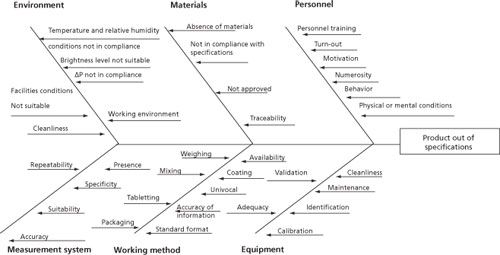
An interdisciplinary team is necessary to properly evaluate all practical and regulatory aspects involving the manufacturing process and the product itself. All activities and their respective planning could be described in a protocol, while a final report will include all the data collected during process validation and their subsequent elaboration. A risk analysis could be also performed; in this case, the aim is to evaluate the manufacturing process and to define parameters/procedures that must undergo a validation activity. The goal of the risk assessment is to evaluate all the single process phases, gain more knowledge of the process itself, and also determine the appropriate control level during validation phases, so that by applying that defined process, a safe and efficacious product is always obtained.
It is important to identify the probable risks and develop a control strategy to minimize risks or keep them under control. To define the critical steps of the manufacturing process, an analysis through a fishbone diagram could be performed. Figure 1 illustrates an example of a fishbone diagram applied to a solid oral dosage form where the risk to analysis is product out of specification.
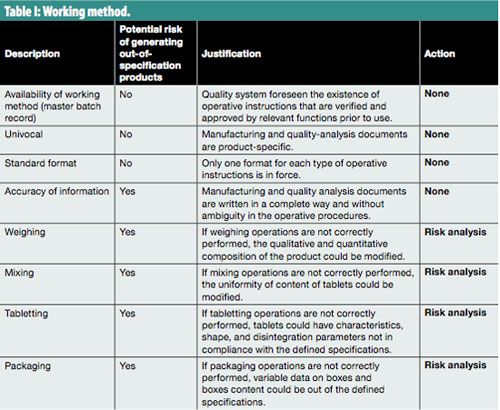
The potential problems that have emerged from the previous step could be analyzed by means of the fault tree analysis (FTA) or a similar logical analysis. The correlation and applicability of each occurrence with the process and process-related factors, such as the facilities and procedure system, are then evaluated by process knowledge. Examples of such tabular output are reported in Table I.
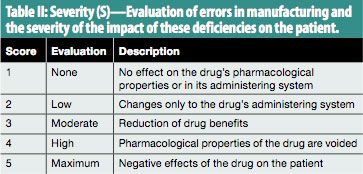
Potential critical factors for a product transfer could be derived from the cause-and-effect fishbone diagram and from the analysis table (Table I). These factors could be analyzed through failure mode and effect and criticality analysis (FMECA) that aim to quantify the risk related to the undesired event. According to severity (S) (see Table II), detectability (D) (see Table III), probability (P) (see Table IV), and impacted phase (F) (see Table V), the risk priority number (RPN) threshold value is then expressed as:
RPN = S x D x P x F
RPNthreshold > X
where X is the threshold value above which additional controls are needed.
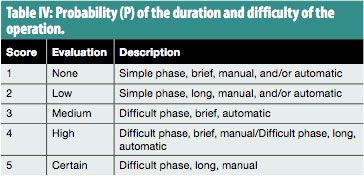
Using this approach, the possible causes of product out of specification could be analyzed. The aim is to find weak points of the manufacturing process. Tables II, III, IV, and V can be used to assign S, D, P, and F scores, respectively. Table VI shows an RPN analysis applied to the mixing phase.
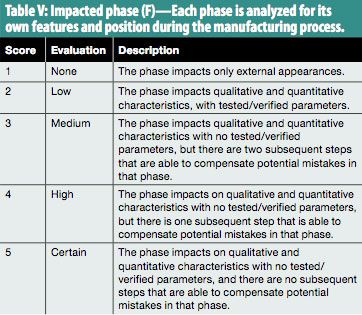
If a phase with an RPN greater than the threshold is detected, methods to change the score of the impacted phase (F) should be considered. In this situation, severity (S) and probability (P) cannot be changed, and adding additional controls to increase detectability (i.e., reduce the detectability score, D) would be undesirable. Additional batches should be manufactured using these methods to verify that F is reduced. In the example discussed, rigorous stop controls were carried out at different mixing times to check the uniformity of the API content in the mixture at different positions in the mixer. The impact of the affected phase was reduced and so was the related RPN. The re-evaluation of RPN is reported in Table VII.
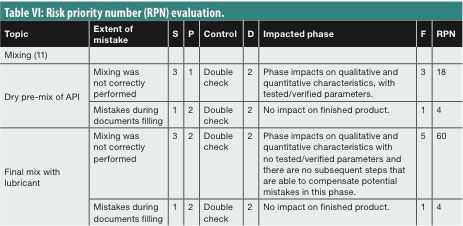
Once the various critical points have been identified and additional tests to reduce the impact of the affected phase have been set, the number of industrial batches can be defined. At the same time, critical steps, in-process controls, and acceptance criteria are defined. When all measurable data related to the process are collected, an evaluation should be performed to obtain objective information on the capacity and strength of the process. Incorporating statistical tools is useful to highlight if the process is in compliance with the defined specifications in relation to the standard deviations, process capability, parametrical, and non-parametrical tests. The pertinent final conclusions together with all the collected data should be reported in the validation report. Possible deviations and the implemented corrective actions should also be enclosed in this document.

References
- FDA, Guidance for Industry: Process Validation: General Principles and Practices (Rockville, MD, January 2011).
- EMA, Guideline on process validation for finished products-information and data to be provided in regulatory submissions (London, February 2014).
- EudraLex, Pharmaceutical Legislation Notice to applicants and regulatory guidelines medicinal products for human use, Volume 2B-Presentation and content of the dossier, Correlation Table EU-CTD (NTA, Vol. 2B, edition May 2006 ) vs. NTA, Vol. 2B (edition 1998), http://ec.europa.eu/health/files/eudralex/vol-2/b/update_200805/ctd_05-2008_en.pdf, accessed 4 Feb. 2015.
- ICH, Q3A(R2) Impurities in new drug substances, Step 4 version (2006).
- ICH, Q3B(R2) Impurities in new drug products, Step 4 version (2006).
- ICH, Q3C(R5) Impurities: guideline for residual solvents, Step 4 version (2011).
- ICH, Q3D Guideline for elemental impurities, Step 4 version (2014).
- EudraLex, Pharmaceutical Legislation Notice to applicants and regulatory guidelines medicinal products for human use, Volume 2C-Regulatory Guideline-Guideline on Summary of Product Characteristics - SmPC, http://ec.europa.eu/health/files/eudralex/vol-2/c/smpc_guideline_rev2_en.pdf, accessed 4 Feb. 2015.
- EudraLex, Pharmaceutical Legislation Notice to applicants and regulatory guidelines medicinal products for human use, Volume 2C-Regulatory Guideline-Guideline on the readability of the labeling and package leaflet of medicinal product for human use, revision 1, http://ec.europa.eu/health/files/eudralex/vol-2/c/2009_01_12_readability_guideline_final_en.pdf, accessed 4 Feb. 2015.
- EMA, Product information templates, www.ema.europa.eu/ema/index.jsp?curl=pages/regulation/document_listing/document_listing_000134.jsp, accessed 4 Feb. 2015.
- Example of process validation for legacy products-ASCCA News 3/2014, www.ascca.net/ascca-news.html, accessed 9 Feb. 2015.
About the Authors
*L. Falce is manufacturing site manager, l.falce@sit-farmaceutici.com;
A. Morreale is manufacturing assistant; and C. Girani is regulatory affairs specialist, all at Laboratorio Farmaceutico SIT, Via Cavour, 70, 27035 Mede, Italy.
*To whom all correspondence should be addressed.
Article DetailsPharmaceutical Technology Europe
Vol. 27, No. 4
Pages: 17-22
Citation: When referring to this article, please cite it as L. Falce, A. Morreale, and C. Girani, “Process Validation of Legacy Product,” Pharmaceutical TechnologyEurope27 (4) 2015.
Drug Solutions Podcast: A Closer Look at mRNA in Oncology and Vaccines
April 30th 2024In this episode fo the Drug Solutions Podcast, etherna’s vice-president of Technology and Innovation, Stefaan De Koker, discusses the merits and challenges of using mRNA as the foundation for therapeutics in oncology as well as for vaccines.
Drug Solutions Podcast: Applying Appropriate Analytics to Drug Development
March 26th 2024In this episode of the Drug Solutions Podcast, Jan Bekker, Vice President of Business Development, Commercial and Technical Operations at BioCina, discusses the latest analytical tools and their applications in the drug development market.
Pharmaceutical Tariffs Are Imminent: How Industry is Bracing for Impact
April 16th 2025On April 14, 2025, the Trump Administration launched a national security-driven investigation into pharmaceuticals, a move that will likely result in tariffs being placed on pharmaceutical drugs, ingredients, and other components that are imported from outside of the United States.